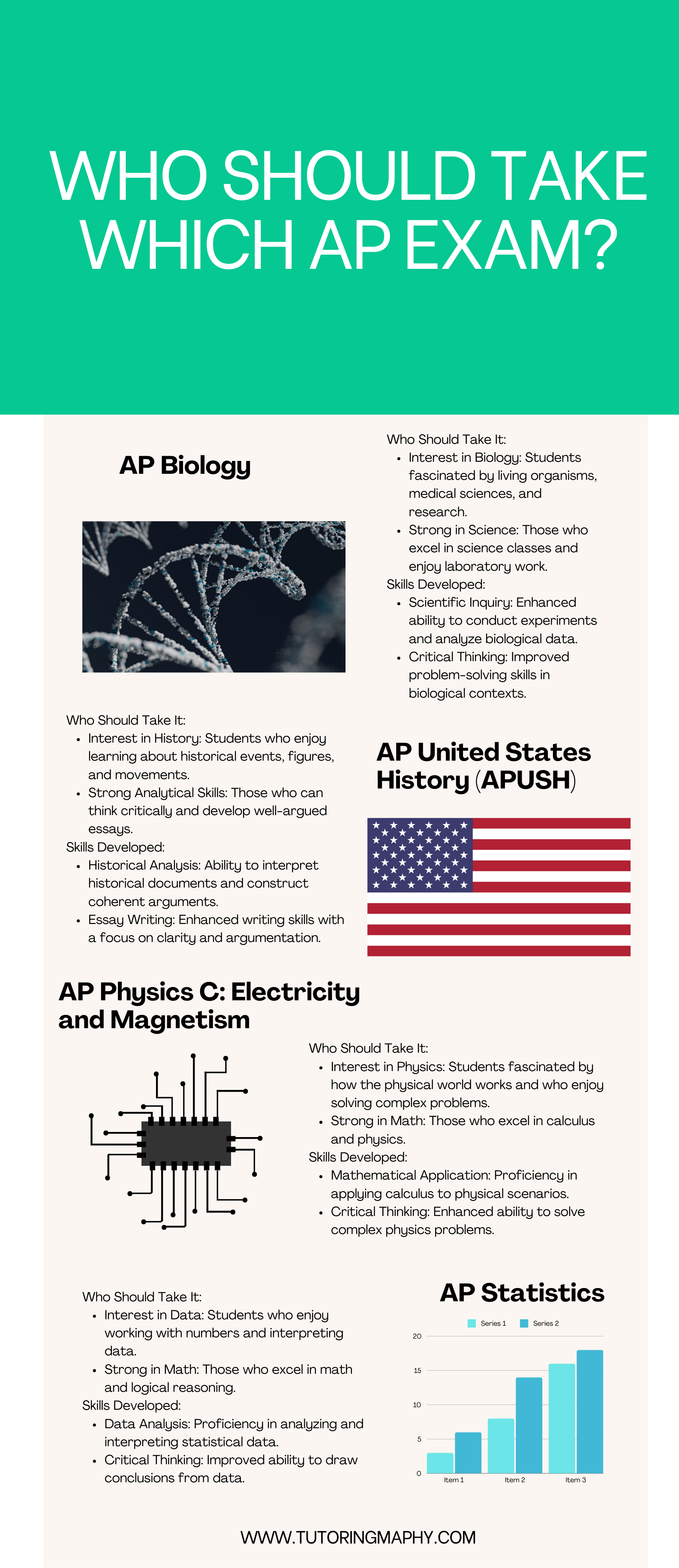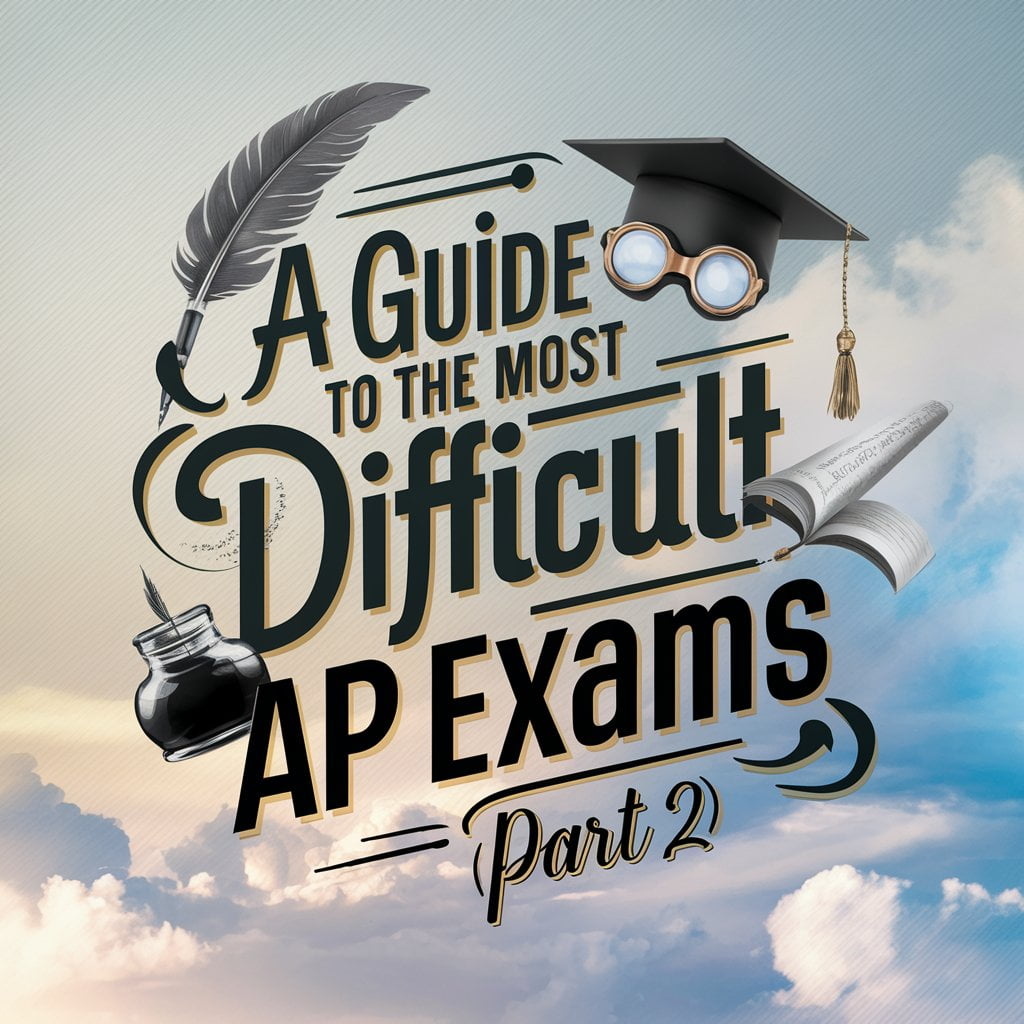- Introduction
- Why are these the most Difficult AP Exams?
- AP United States History (APUSH)
- AP Biology
- AP Physics C: Electricity and Magnetism
- AP Statistics
- Effective Study Strategies for AP Statistics
- Conclusion
- Final Tips for Managing Difficult AP Exams
- Encouragement and Resources for Further Study
- Frequently Asked Questions (FRQs)
Introduction
Welcome back to our series, “AP Exams That Push Limits: A Guide to the Most Difficult AP Exams Part 2” In Part 1, we carefully looked at AP Calculus BC, AP Physics C: Mechanics, AP Chemistry, and AP English Literature. Now, we continue our journey by inquiring into four more AP exams that are equally formidable: AP Biology, AP United States History, AP Physics C : Electricity and Magnetism and AP Statistics. These exams are known for their demanding content, extensive coverage, and the high level of critical thinking required to succeed.
Why are these the most Difficult AP Exams?
1. AP Biology
Complex Content: AP Biology covers a vast array of topics from cellular processes and genetics to ecology and evolution, requiring students to have a broad and deep understanding of biological concepts.
Scientific Inquiry: The exam tests not just memorization but the ability to apply scientific methods and analyze experimental data.
2. AP United States History
Broad Scope: This exam encompasses the entire span of American history, from pre-Columbian times to the present, demanding extensive factual knowledge.
Analytical Skills: Students must analyze historical documents, develop arguments, and write coherent essays that demonstrate a deep understanding of historical themes and events.
3. AP Physics C: Electricity and Magnetism
Mathematical Rigor: The mathematical severity of this course stems from its reliance on calculus to explain and solve physical problems.
Application of Concepts: The course also demands high-level critical thinking to apply these mathematical principles to real-world situations and experimental data.
4. AP Statistics
Mathematical Rigor: This exam involves interpreting data, understanding probability, and performing various statistical analyses, requiring both theoretical knowledge and practical application.
Critical Thinking: Students must design experiments, analyze real-world data, and draw valid conclusions based on statistical evidence.
AP United States History (APUSH)
APUSH: What Makes It So Challenging?
AP United States History (APUSH) is renowned for its breadth and depth, requiring students to master a vast array of historical facts, themes, and analytical skills. The course spans from pre-Columbian times to the present day, encompassing significant events, figures, and movements that have shaped the nation. The challenge lies not only in the sheer volume of content but also in the critical thinking and synthesis required to analyze historical documents and craft well-argued essays. The exam has different parts like multiple-choice questions, short answers, a document-based question (DBQ), and a long essay question. Each part checks different abilities..
Key Themes and Topics in APUSH
1. Colonial America
- European exploration and colonization
- Native American interactions and conflicts
- Development of colonial societies and economies
2. American Revolution and the New Nation
- Causes and consequences of the Revolution
- Formation and ratification of the Constitution
- Early republic and challenges faced by the new nation
3. Civil War and Reconstruction
- Causes and impacts of the Civil War
- Reconstruction policies and their effects on the South
- Changes in social and political structures post-war
4. Industrialization and the Gilded Age
- Growth of industry and urbanization
- Social and economic inequalities
- Labor movements and political reforms
5. 20th Century Conflicts and Changes
- World Wars and their domestic impacts
- The Great Depression and New Deal
- Civil Rights Movement and social transformations
6. Contemporary America
- Post-Cold War era
- Economic, technological, and cultural shifts
- Recent political developments and challenges
Effective Study Strategies for APUSH
1. Create a Timeline
Develop a comprehensive timeline of major events, laws, and presidential terms. This helps in understanding the chronological flow and contextual relationships.
2. Focus on Themes
Identify and focus on key themes such as democracy, freedom, and social change. Understand how these themes evolve over different periods.
3. Practice DBQs
Regularly practice document-based questions to hone your skills in analyzing primary sources and constructing coherent arguments.
4. Use Review Books and Online Resources
Utilize APUSH review books and reliable online resources like Tutoringmaphy, Khan Academy and College Board’s AP Classroom for structured content review and practice tests.
5. Join Study Groups
Collaborate with peers to discuss and review material. Teaching others helps you understand things better.
AP Biology
AP Biology is a demanding, college-level course designed to provide students with a deep understanding of biological concepts and processes. It covers a wide range of topics, including biochemistry, cell biology, genetics, evolution, ecology, and physiology. The course emphasizes scientific inquiry, reasoning, and analytical skills, preparing students for higher education and careers in the biological sciences.
Critical Topics and Concepts in AP Biology
1. Biochemistry
- Structure and function of macromolecules
- Enzyme activity and regulation
2. Cell Biology
- Cell structure and function
- Cellular respiration and photosynthesis
- Cell communication and signaling
3. Genetics
- Mendelian genetics and inheritance patterns
- Molecular genetics, including DNA replication, transcription, and translation
- Biotechnology and genetic engineering
4. Evolution
- Principles of natural selection and speciation
- Evolutionary history and phylogenetics
5. Ecology
- Ecosystem dynamics and energy flow
- Population ecology and environmental interactions
6. Physiology
- Homeostasis and organ systems
- Plant and animal physiology
Study Tips for AP Biology Success
1. Create Detailed Study Guides
Summarize each chapter’s key points and concepts. Use diagrams and charts to visualize complex processes.
2. Practice with Past Exams
Get to know how the exam is structured and what kinds of questions to expect. Practice free-response questions and multiple-choice tests.
3. Engage in Active Learning
Participate in lab experiments, group discussions, and study sessions. Explain concepts to your friends or classmates to make sure you understand them well.
4. Use Mnemonics and Flashcards
Develop mnemonic devices for memorizing processes and terms. Use flashcards for quick reviews and self-testing.
5. Leverage Online Resources
Utilize educational websites, video tutorials, and AP review books for additional explanations and practice problems.
AP Physics C: Electricity and Magnetism
AP Physics C: Electricity and Magnetism (E&M) is an advanced, calculus-based physics course that investigate into the principles and applications of electric and magnetic fields. This course is designed for students with a strong foundation in both physics and calculus, as it requires a deep understanding of mathematical concepts to solve complex problems. The AP exam is divided into two sections: multiple-choice and free-response, both of which test students’ ability to apply theoretical knowledge to practical scenarios.
Key Concepts in AP Physics C: E&M
1. Electrostatics
- Coulomb’s law
- Electric fields and potential
- Capacitance and dielectrics
2. Conductors, Capacitors, and Dielectrics
- Behavior of conductors in electrostatic equilibrium
- Capacitance calculations
- Energy stored in capacitors
3. Electric Circuits
- Ohm’s law and Kirchhoff’s rules
- Series and parallel circuits
- RC circuits and transient analysis
4. Magnetic Fields
- Biot-Savart law and Ampère’s law
- Magnetic force on moving charges and current-carrying wires
- Magnetic flux and Gauss’s law for magnetism
5. Electromagnetism
- Faraday’s law of induction
- Lenz’s law
- Inductors and RL circuits
6. Maxwell’s Equations
- Gauss’s laws for electricity and magnetism
- Faraday’s law of induction
- Ampère’s law with Maxwell’s addition
For further details, checkout this official release from College board.
Strategies for Excelling in AP Physics C: E&M
1. Solidify Your Calculus Skills
Ensure you are comfortable with integrals and derivatives, as these mathematical tools are essential for understanding electric and magnetic fields.
2. Understand the Fundamental Principles
Focus on grasping the core concepts before diving into complex problems. A solid understanding of basics like Coulomb’s law and Faraday’s law is crucial.
3. Practice Problem-Solving
Regularly solve past exam questions and practice problems. This helps you become familiar with the types of questions asked and the methods for solving them.
4. Visualize the Problems
Use diagrams and sketches to visualize electric and magnetic fields, circuit configurations, and flux changes. Pictures or diagrams can help you grasp difficult ideas more easily.
5. Engage in Lab Work
Hands-on experiments help solidify theoretical knowledge. Perform and analyze labs to gain practical insights into concepts like induction and circuit behavior.
Are you planning to take AP Physics C Electricity and Magnetism, check out Succeeding in AP Physics C Electricity and Magnetism
AP Statistics
AP Statistics is a college-level course that introduces students to the major concepts and tools used for collecting, analyzing, and drawing conclusions from data. This course emphasizes statistical thinking and teaches students how to interpret data critically and make informed decisions. The AP Statistics exam tests students’ understanding through multiple-choice questions and free-response questions, requiring both theoretical knowledge and practical application.
Key Topics and Concepts in AP Statistics
1. Exploring Data
- Describing Patterns and Departures from Patterns: Understanding measures of central tendency (mean, median, mode), measures of spread (range, interquartile range, standard deviation), and the shape of data distributions (skewness, kurtosis).
- Graphical Representations: Creating and interpreting histograms, box plots, scatterplots, and bar charts.
2. Sampling and Experimentation
- Designing Samples and Experiments: Understanding sampling methods (random, stratified, cluster) and experimental design principles (control, randomization, replication, and blocking).
- Data Collection: Differentiating between observational studies and experiments, and understanding sources of bias and confounding variables.
3. Anticipating Patterns
- Probability: Understanding the basics of probability, including conditional probability and the rules of probability (addition and multiplication rules).
- Random Variables: Differentiating between discrete and continuous random variables and calculating expected values and variances.
- Probability Distributions: Working with binomial, geometric, and normal distributions.
4. Statistical Inference
- Estimating Population Parameters: Constructing and interpreting confidence intervals for means, proportions, and differences between means and proportions.
- Testing Hypotheses: Formulating and testing hypotheses using significance tests (t-tests, chi-square tests, and ANOVA).
- Regression and Correlation: Analyzing the relationship between variables using linear regression and correlation coefficients, and understanding the concept of least-squares regression.
Effective Study Strategies for AP Statistics
1. Focus on understanding the underlying principles of statistics rather than just memorizing formulas
Concepts like variability, correlation, and probability are fundamental to the course.
2. Practice with Real Data
Work with real-world data sets to apply statistical methods. This hands-on approach helps solidify your understanding and prepares you for the types of questions you’ll encounter on the exam.
3. Use Graphing Calculators
Familiarize yourself with the statistical functions of your graphing calculator. Learn how to perform calculations, create graphs, and run simulations efficiently.
4. Solve Past Exam Questions
Practice with past AP Statistics exam questions to get a sense of the format and types of questions asked. Check the scoring rules to understand how your answers are graded. To download AP Statistics PYQs, check this out .
5. Collaborate and Discuss
Join study groups or online forums where you can talk about difficult subjects. Explaining things to others and hearing different opinions can help you understand better.
Conclusion

In Part 2 of our series on the most difficult AP exams, we explored several courses that are known for their difficulty level and demand:
1. AP United States History (APUSH)
Challenges: Extensive content coverage, analytical essay writing, and complex historical analysis.
Key Themes: American identity, politics and power, and social change.
2. AP Biology
Challenges: Broad scope of material, detailed understanding of biological processes, and laboratory skills.
Critical Topics: Evolution, cellular processes, genetics, and ecology.
3. AP Physics C: Electricity and Magnetism
Challenges: Advanced calculus-based physics concepts and problem-solving.
Key Concepts: Electrostatics, circuits, magnetic fields, and electromagnetism.
4. AP Statistics
Challenges: Conceptual understanding of statistical methods and data interpretation.
Key Topics: Probability, sampling, inference, and regression analysis.
Each of these exams pushes students to develop a deep understanding of complex topics and to apply critical thinking and problem-solving skills. They require diligent study, consistent practice, and a strategic approach to mastering the material.
Do you know how many AP exams are in total? This blog has all the details the list of all AP exams.
Final Tips for Managing Difficult AP Exams
1. Start Early and Plan Ahead
Begin studying well in advance of the exam date. Make a study plan that lets you go through all the topics one by one.
2. Use Quality Resources
Utilize textbooks, review books, online courses, and practice exams. The College Board website offers valuable resources, including past exam questions and scoring guidelines.
3. Focus on Weak Areas
Identify your weak points and allocate extra time to improve in those areas. Regular self-assessment through quizzes and practice tests can help pinpoint these weaknesses.
4. Practice, Practice, Practice
Consistent practice is crucial for subjects that involve problem-solving, such as math and physics. For subjects like history and biology, practice writing essays and answering free-response questions.
5. Form Study Groups
Studying with peers can provide different perspectives and insights. Talking about and teaching concepts to others can help you understand them better.
6. Seek Help When Needed
If you need help, don’t be afraid to ask teachers, tutors, or classmates. Online forums and study groups can also be useful places to get assistance.
7. Take Care of Yourself
Maintain a balanced study routine with breaks, exercise, and adequate sleep. Managing stress and staying healthy are important for optimal performance.
Interested to know how long are these AP exams? Read AP Exam Length: How long are AP exams?
Encouragement and Resources for Further Study
Taking on the toughest AP exams is a commendable challenge that demonstrates your dedication and academic ambition. Remember, the skills and knowledge you gain from these courses extend beyond the exam itself, preparing you for future academic and professional success.
Here are some additional resources to support your studies:
YouTube: Channels like Tutoringmaphy offer engaging video tutorials on various AP subjects.
College Board: Provides official AP exam practice questions, course descriptions, and scoring guidelines.
Khan Academy: Offers free online courses and practice problems for many AP subjects.
Review Books: Books from publishers like Princeton Review and Barron’s provide comprehensive review and practice exams.
Frequently Asked Questions (FRQs)
Q. How difficult is APUSH compared to other AP exams?
APUSH is considered challenging due to its extensive content and analytical essay requirements. It requires a deep understanding of historical events, themes, and their implications, making it one of the more demanding AP courses. However, with diligent study and effective preparation strategies, success is attainable.
Q. How difficult is AP Biology in terms of content depth?
AP Biology covers a wide range of topics, from cellular processes to ecology, requiring students to have a comprehensive understanding of biological concepts. The depth of content can make AP Biology challenging, but with consistent study and practice, students can master the material and succeed in the exam.
Q. How difficult is AP Physics C compared to other physics courses?
AP Physics C: Electricity and Magnetism is considered one of the most challenging AP physics courses due to its calculus-based approach and complex concepts. It requires a strong understanding of calculus and physics principles, making it particularly rigorous. However, students who are well-prepared and proficient in calculus and physics can excel in this course.
Q. Is AP Statistics considered a difficult AP exam?
AP Statistics is challenging in its own right, but it may be perceived as less difficult compared to other AP exams such as AP Physics C or AP Calculus BC. The difficulty of AP Statistics lies in its emphasis on conceptual understanding and data analysis rather than mathematical computation. With focused study and practice interpreting data and applying statistical methods, you can perform well on the exam.
Q. How difficult is it to get a 5 on an AP test?
Achieving a score of 5 on an AP exam depends on various factors, including the individual’s study habits, prior knowledge of the subject, and familiarity with the exam format. While it can be challenging, strategic preparation, consistent practice, and effective use of resources can increase the likelihood of earning a top score.
How many APs would make the cut? Find out the sweet spot on How many AP Classes should you take?



